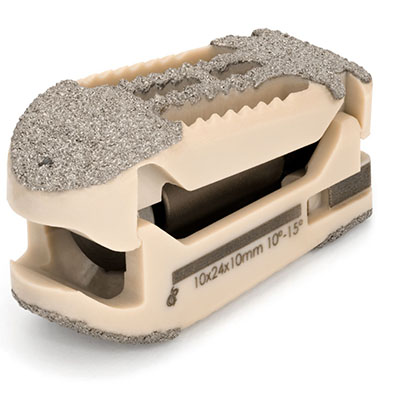
Content sponsored by Orchid Orthopedic Solutions
Coatings, as they relate to orthopedic implants, can mean different things. Bioactive coatings are intended to inhibit bacterial growth that can lead to infection. Surface coatings can be applied or built into the actual implant surface to address implant fixation. Four of the five companies listed below have employed the latter in products that received regulatory clearance and launched within the last year. Vallum, the fifth company, does not have a coating but is included for what its surface technology can do.
Corin commenced limited launch of the Trinity PLUS acetabular cup. Trinity PLUS features a highly porous acetabular cup made via additive manufacturing to deliver a randomized 3D structure that mimics the range of pore size in trabecular bone. Corin claims that this creates a coating that is present throughout the network of interconnected cells, not just on the cup’s surface. Trinity PLUS can be used with all Trinity bearings and can complement the Trinity™ Dual Mobility Hip.
DJO launched the EMPOWR Porous™ Knee, designed for both immediate and longterm biologic fixation. The device features P2™, a proprietary porous titanium coating designed to provide superior bone ingrowth.
Shoulder Innovations received FDA 510(k) clearance to market the InSet Humeral Short Stem system for total and partial shoulder arthroplasty. InSet features streamlined instrumentation and a proprietary coating for implant fixation. It can be used with the company’s InSet glenoid implant as a bone-sparing option to treat humeral or glenoid deformities.
Spinal Elements was granted additional FDA 510(k) clearance for claims related to the macro-, micro- and nano-surface structure of its Ti-Bond® hydrophilic porous titanium coating used at the bone-contacting endplates of the implant. Spinal Elements utilizes Ti-Bond in multiple products, including the Lucent® XP expandable interbody device.
  |   |   | |||
| Corin Trinity PLUS | DJO EMPOWR Porous Knee | Spinal Elements Ti-Bond |
Vallum received FDA 510(k) clearance to market a polyetheretherketone (PEEK) interbody fusion device with a PEEKplus® nanotextured surface created with proprietary Accelerated Neutral Atom Beam (ANAB) technology. This reportedly represents the first FDA-cleared nanotextured surface on a PEEK interbody. In the PEEKplus process, nanoscale concavities of 20 to 50 nanometers are created by the impact of argon atoms across the entire microsurface of the PEEK. PEEKplus is not a coating, is not porous and no chemicals are infused into the PEEK. This nanotexturing technology may be applied to any fully-manufactured PEEK interbody device without altering its design or size, and without affecting mechanical or chemical properties. The ANAB processor is an additional manufacturing step for the device and is performed last. Vallum believes that its technology and processing protocols can be developed to improve other devices. The images from top to bottom—Corin Trinity PLUS, DJO EMPOWR Porous Knee and Spinal Elements Lucent XP—are used courtesy of the manufacturers.
JAV
Julie A. Vetalice is ORTHOWORLD's Editorial Assistant. She has covered the orthopedic industry for over 20 years, having joined the company in 1999.




